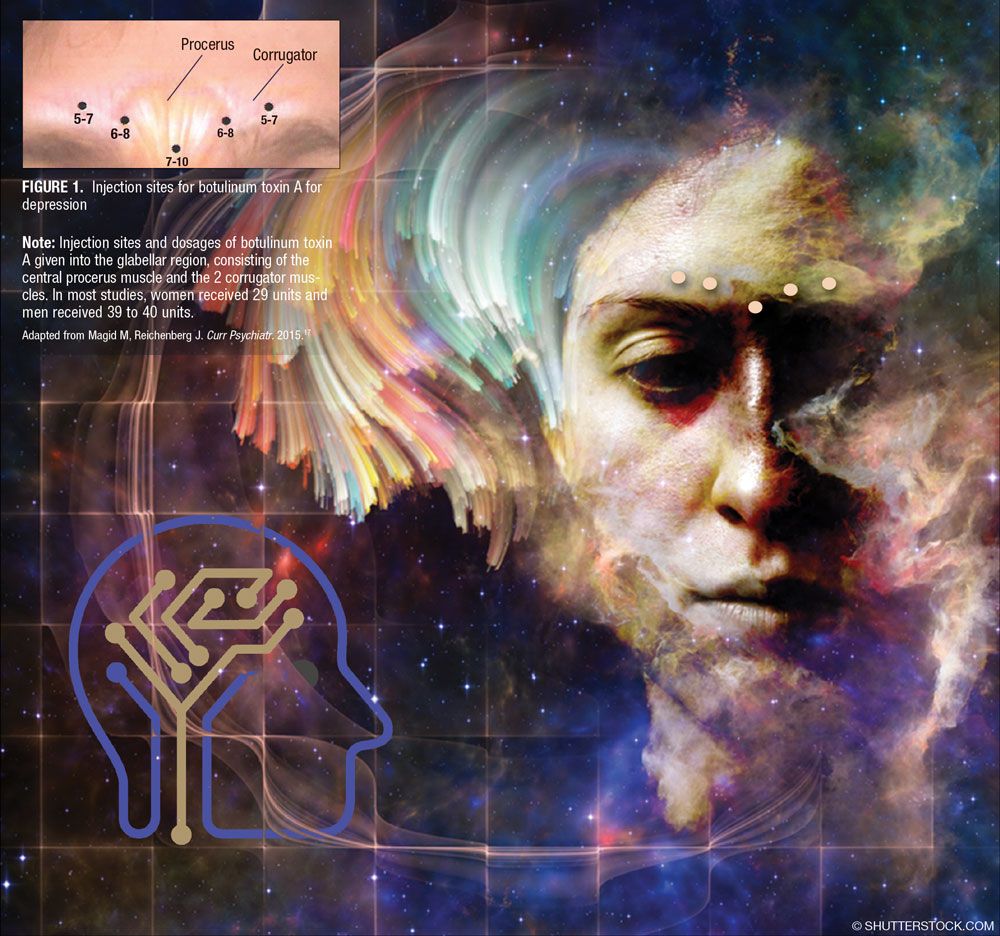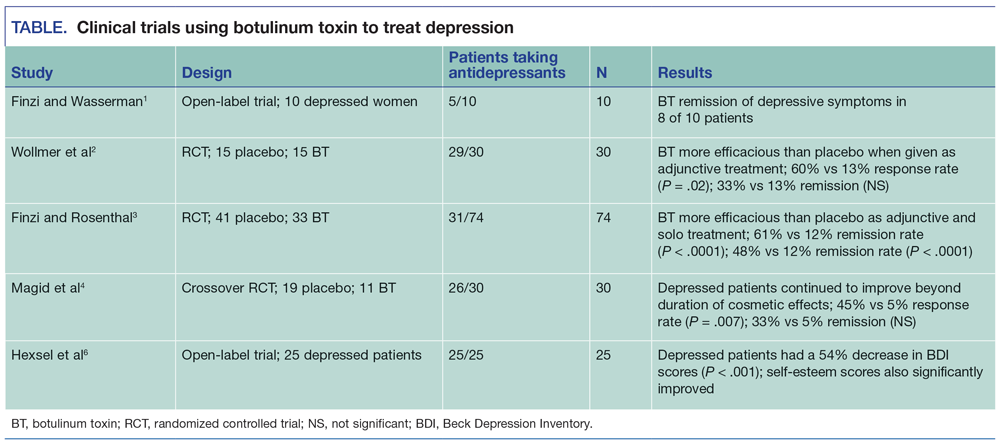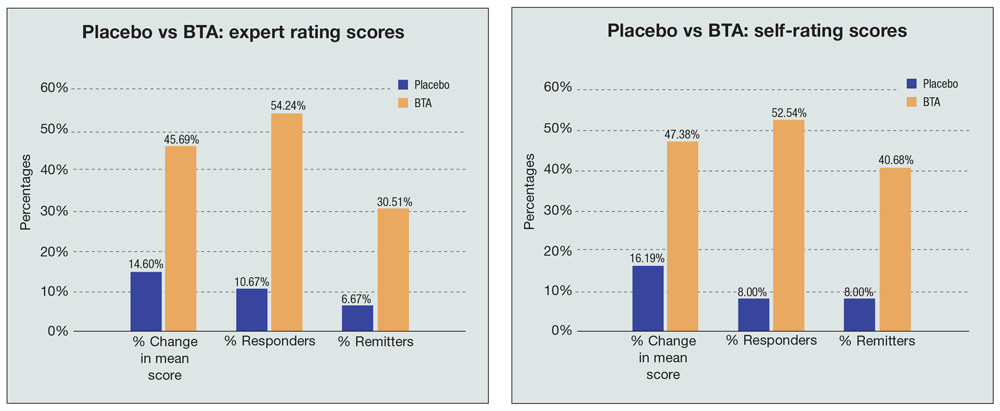Publication
Article
Psychiatric Times
Botulinum Toxin for Depression? Emotional Proprioception
Author(s):
If larger trials confirm the strong antidepressant effects observed so far, botulinum toxin may become a standard therapeutic addition to the psychiatric armamentarium.
FIGURE 1. © shutterstock.com

TABLE. Clinical trials using botulinum toxin to treat depression

FIGURE 2.

In the first open-label trial of botulinum toxin a (bt) for depression, 8 of 10 subjects went into remission within 2 months after a single treatment of the corrugator (frown) muscles with BT.1 Subsequently, results from 3 randomized controlled trials (RCTs) showed that a single injection of BT into the corrugator muscles had significant antidepressant effects (Figure 1).2-4 In the largest RCT, BT appeared to be equally effective as either monotherapy or augmentation therapy.3
We present here the evidence for using BT as a treatment for depression, discuss possible mechanisms for this effect, and address some questions about this novel treatment.
At first glance the use of BT to treat depression may seem surprising; however, a line of thinking dating back to the 1800s might have predicted it. While it is commonly recognized that our emotions influence our facial expressions, the reverse is less obvious. Yet both Charles Darwin and William James proposed this to be so.
Darwin observed that strong contraction of the brow muscles, forming an omega sign between the eyebrows, is an indicator of melancholy-the sign disappeared when a person felt better. James famously stated that he was sad because he cried; not that he cried because he was sad. Both men hypothesized that facial expressions of sorrow or grief sent signals to the emotional part of the brain, inducing or exacerbating feelings of distress.
Facial feedback hypothesis
Over time numerous studies confirmed what became known as the “facial feedback hypothesis.” Researchers systematically investigated the effects on emotions when, either consciously or unconsciously, muscles of facial expression were activated. The voluntary contraction of facial muscles into a smile or frown induced feelings of happiness or sadness, respectively. Frowning, regardless of why, causes people to rate unpleasant photographs more negatively, cartoons less funny, and stories less appealing. Conversely, smiling makes everything more appealing. Facial expressions appear to aid the brain in assigning a valence to emotions and are thus important for decision-making.
The effects of facial expressions on emotions extend to bodily functions outside of our normal conscious control. Ekman and colleagues5 showed that re-creation of facial movements associated with expressions such as happiness, sadness, anger, and fear change autonomic nervous system responses. Heart rate, blood pressure, and sweating are all altered by contracting facial muscles, and this effect is stronger than recalling a strong emotional memory. In summary, converging lines of evidence suggest that contraction of facial muscles affects mood; smiling promotes happy mood while frowning promotes gloomy mood.
Evidence for botulinum toxin treatment of depression
So far, there have been 2 open-label studies and 3 RCTs of the effects on depression after BT injection into corrugator muscles (Table).
Open-label studies. In the first test of the facial feedback hypothesis, as applied to depression, 10 people who had been depressed for a year or more received a single treatment with BT.1 Scores on the Beck Depression Inventory (BDI) decreased by 73% (P < .005). In a second case series of 25 depressed individuals, scores on the BDI decreased by 54% 12 weeks after 1 BT treatment (14.9 point drop on BDI; P < .001).6
Random-controlled treatment studies. In all 3 studies, women received 29 units of BT and men 39 or 40 units, to account for muscle mass differences. All 3 RCTs produced results consistent with the earlier open-label studies: the response rate ranged between 40% and 61%, as measured by standardized scales used in the different studies: Hamilton Depression Rating Scale (HAM-D), Montgomery-Asberg Depression Rating Scale (MADRS), or BDI. The remission rate ranged from 27% to 48%. In the largest clinical trial (74 subjects), there was a 61% response rate with BT versus 12% with placebo (P < .001), and a 48% versus 12% remission rate (P < .001), as measured by BDI.3
A pooled analysis of the 3 RCTs, consisting of 134 depressed patients who received BT (n = 59) or placebo (n = 74) into the glabellar frown region, showed that BDI scores in the BT group had decreased by 47% (14 points) relative to a 16% (5 points) decrease in the placebo group (P < .0001, Figure 2).7,8 The pooled response rate was 52% versus 8% (P <.0001), and remission rate 42% vs 8% (P < .0001). Variables such as age, sex, depression severity, and concomitant antidepressant use were not significantly associated with response.
In summary, 2 open-label and 3 RCT studies found that BT injection into corrugator muscles has significant antidepressant effects. Moreover, no studies published to date have failed to show this effect. As administered in these studies, BT appears to be an effective antidepressant treatment.
How effective is this treatment compared with a typical antidepressant?
In RCTs to date, the antidepressant effect of BT has been strong. The effect size, or Cohen’s d, of the largest clinical trial was 0.84, which is comparable to successful antidepressant trials.
Does it work by making people look better?
One might legitimately raise the question whether depressed patients who receive BT feel better because they look better. This seems unlikely, since the majority of subjects had little or no visible frown at rest before treatment. Improvement in frown scores did not correlate with improvement in mood.9 Many subjects who had no baseline frown lines had remission of depression symptoms. There were even patients who did not like the cosmetic change yet felt less depressed.2
Who is most likely to respond to BT?
It is too early to answer this question definitively. The European RCT found that those who were more anxious or agitated responded better to BT, but we recognize the need to see this preliminary finding replicated.10 BT appears to be equally effective as either monotherapy or augmentation of existing treatment, as noted in the largest clinical trial and the pooled analysis.3,7
The RCTs comprised mostly women (90%). We have no reason, however, to suspect a male-female difference, but larger trials with more men are warranted.
How safe is the treatment?
Fortunately, we have very good data on this. BT has been used for more than 20 years, in millions of subjects, in the glabellar location, with a remarkable safety record. The dosages used for depression are in the range that has been studied extensively. Adverse effects such as headache and pain may occur but are usually minor and temporary. Eyelid droop may rarely occur and is also temporary.
Apart from local irritation, temporary headache was the only adverse event seen in the pooled analysis of RCTs, and it did not differ between BT and placebo groups. In summary, in the location and doses described here, BT is very safe. The long-term antidepressant effect of BT usually lasts about 3 months.
How quickly does it work and how long does it last?
Anecdotally, some patients report feeling better in days, but the earliest follow-up in a RCT has been 2 weeks, at which time some response was already apparent when BT was compared with placebo (P < .05). In the majority of patients, depressive symptoms will eventually return after the BT has worn off, sometime between 3 and 6 months. If depression symptoms repeatedly return, we usually advise patients to consider receiving maintenance BT injections every 3 months, the same regimen used for migraine headache treatment.
What is the mechanism of action?
BT has been shown to block release of acetylcholine from motor neurons, paralyzing muscles. In addition, BT may suppress the release of inflammatory cytokines from sensory neurons.
Several lines of research suggest that facial expressions are an important input to emotional circuits in the brain. Three emotions-anger, fear, and sadness-activate contraction of the corrugator muscle in the glabellar region. A link between corrugator muscle activity and amygdala activation has been observed.11 Moreover, depressed patients who experience remission of symptoms induced either by paroxetine or by cognitive behavioral therapy show reduced amygdala overactivity. Functional MRI shows that people who receive BT injections into corrugator muscles have diminished amygdala responses to negative stimuli. When the BT wears off, amygdala activity returns to its original state, confirming that BT reversibly severed afferent feedback from the corrugator muscle to the amygdala.12
We propose that afferent nerve fibers relay emotional information from muscles of facial expression to the brain on a moment to moment basis, signaling our emotional states, by a process termed emotional proprioception.13,14 Muscular activity in the brow region sends signals along proprioceptive fibers of the optic branch of the trigeminal nerve. This signal has been shown to travel to the mesencephalic trigeminal nucleus and locus ceruleus-the latter has direct connections to both the amygdala and the ventromedial prefrontal cortex-structures critical for emotional regulation.15
BT treatment of the frown, by temporally paralyzing the corrugator muscles, would interrupt the normal circuitry, reduce distress signals to the brain, and thereby influence mood in a favorable way. Thus, by injecting BT into the brow and activating the emotional proprioceptive pathway, we are literally relieving the pain and stress carried by the corrugator muscles of the brow, supporting a theory first proposed by Charles Darwin 150 years ago.
Status of BT for depression
The use of BT for depression is currently in phase 3 clinical trials. Therefore, patients should be informed that the treatment of depression with BT is an off-label use not covered by insurance. If larger trials confirm the strong antidepressant effects observed so far, BT may become a standard therapeutic approach to add to the psychiatric armamentarium to treat depression.
Other potential psychiatric uses for BT
Because the emotional brain circuitry affected by depression may also be involved in other emotional disorders, we anticipate that the use of BT injections into the brow may also benefit other conditions, as described below.
Borderline personality disorder. One case series reported that patients with severe borderline personality disorder were successfully treated with BT.16 An RCT is in progress (ClinicalTrials.gov, NCT02728778).
Social anxiety disorder. Several of our patients have noted improvement of social anxiety symptoms after treatment with BT. An RCT is in progress (ClinicalTrials.gov, NCT03078270).
PTSD. We have successfully treated several patients with this disorder.
Seasonal affective disorder (SAD). Several of our patients with a history of SAD that was not fully responsive to light therapy and/or SSRIs responded to BT. In addition, in some patients BT successfully treated residual symptoms. SAD was successfully prevented by treatment with BT 1 month before the usual onset of symptoms.
Disclosures:
Dr. Finzi is Clinical Assistant Professor of Psychiatry, George Washington University, Washington, DC; Dr. Rosenthal is Clinical Professor of Psychiatry, Georgetown Medical School, Washington, DC.
Dr. Finzi reports that he is a named inventor on 2 patents to treat depression with botulinum toxin; he has been a consultant to Allergan; and he is a co-inventor on a patent to treat social anxiety disorder with botulinum toxin. Dr. Rosenthal reports that he has applied for patents to use botulinum toxin to treat social anxiety disorder, PTSD, and seasonal affective disorder; the first of these 3 patent applications has been granted.
References:
1. Finzi E, Wasserman E. Treatment of depression with botulinum toxin A: a case series. Dermatol Surg. 2006;32:645-649.
2. Wollmer MA, de Boer C, Kalak N, et al. Facing depression with botulinum toxin: a randomized controlled trial. J Psychiatr Res. 2012;46:574-581.
3. Finzi E, Rosenthal NE. Treatment of depression with onabotulinumtoxinA: a randomized, double-blind, placebo controlled trial. J Psychiatr Res. 2014;52:1-6.
4. Magid M, Reichenberg JS, Poth PE, et al. Treatment of major depressive disorder using botulinum toxin A: a 24-week randomized, double-blind, placebo-controlled study. J Clin Psychiatry. 2014;75:837-844.
5. Ekman P, Levenson PW, Friesen WV. Autonomic nervous system activity distinguishes among emotions. Science. 1983;4616:1208-1210.
6. Hexsel D, Brum C, Siega C, et al. Evaluation of self-esteem and depression symptoms in depressed and nondepressed subjects treated with onabotulinumtoxinA for glabellar lines. Dermatol Surg. 2013;39:1088-1096.
7. Magid M, Finzi E, Kruger TH, et al. Treating depression with botulinum toxin: a pooled analysis of randomized controlled trials. Pharmacopsychiatry. 2015;48:205-210.
8. Parsaik A, Mascarenhas S, Hashmi A, et al. Role of botulinum toxin in depression. J Psychiatr Pract. 2016;22:99-110.
9. Reichenberg JS, Hauptman AJ, Robertson HT, et al. Botulinum toxin for depression: does patient appearance matter? J Am Acad Dermatol. 2016;74:171-173.
10. Wollmer MA, Kalak N, Jung S, et al. Agitation predicts response of depression to botulinum toxin treatment in a randomized controlled trial. Front Psychiatry. 2014;5:36.
11. Heller AS, Lapate RC, Mayer KE, Davidson RJ. The face of negative affect: trial-by-trial corrugator responses to negative pictures are positively associated with amygdala and negatively associated with ventromedial pre- frontal cortex activity. J Cogn Neurosci. 2014;26:2102-2110.
12. Kim MJ, Neta M, Davis FC, et al. Botulinum toxin-induced facial muscle paralysis affects amygdala responses to the perception of emotional expressions: preliminary findings from an A-B-A design. Biol Mood Anxiety Disord. 2014;4:11.
13. Finzi E. The Face of Emotion: How Botox Affects Moods and Relationships. New York: Palgrave-Macmillan; 2013.
14. Finzi E, Rosenthal NE. Emotional proprioception: treatment of depression with afferent facial feedback. J Psychiat Res. 2016;80:93-96.
15. Matsuo K, Ban R, Hama Y, Yuzuriha S. Eyelid opening with trigeminal proprioceptive activation regulates a brainstem arousal mechanism. PLoS One. 2015;10:e0134659.
16. Kruger TH, Magid M, Wollmer MA. Can botulinum toxin help patients with borderline personality disorder? Am J Psychiatry. 2017;173:940-941.
17. Magid M, Reichenberg J. Botulinum toxin for depression? An idea that's raising some eyebrows. Curr Psychiatr. 2015;14:43-56.






